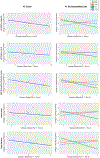Selecting an optimal real-time fMRI neurofeedback method for alcohol craving control training
- PMID: 37326428
- PMCID: PMC11748215
- DOI: 10.1111/psyp.14367
Selecting an optimal real-time fMRI neurofeedback method for alcohol craving control training
Abstract
Real-time fMRI neurofeedback (rt-fMRI-NF) is a technique in which information about an individual's neural state is given back to them, typically to enable and reinforce neuromodulation. Its clinical potential has been demonstrated in several applications, but lack of evidence on optimal parameters limits clinical utility of the technique. This study aimed to identify optimal parameters for rt-fMRI-NF-aided craving regulation training in alcohol use disorder (AUD). Adults with AUD (n = 30) participated in a single-session study of four runs of rt-fMRI-NF where they downregulated "craving-related" brain activity. They received one of three types of neurofeedback: multi-region of interest (ROI), support vector machine with continuous feedback (cSVM), and support vector machine with intermittent feedback (iSVM). Performance was assessed on the success rate, change in neural downregulation, and change in self-reported craving for alcohol. Participants had more successful trials in run 4 versus 1, as well as improved downregulation of the insula, anterior cingulate, and dorsolateral prefrontal cortex (dlPFC). Greater downregulation of the latter two regions predicted greater reduction in craving. iSVM performed significantly worse than the other two methods. Downregulation of the striatum and dlPFC, enabled by ROI but not cSVM neurofeedback, was correlated with a greater reduction in craving. rt-fMRI-NF training for downregulation of alcohol craving in individuals with AUD shows potential for clinical use, though this pilot study should be followed with a larger randomized-control trial before clinical meaningfulness can be established. Preliminary results suggest an advantage of multi-ROI over SVM and intermittent feedback approaches.
Keywords: alcohol use disorder; craving; fMRI; methods; neurofeedback; neuromodulation.
Published 2023. This article is a U.S. Government work and is in the public domain in the USA.
Conflict of interest statement
DECLARATIONS OF INTEREST
None
Figures




References
Publication types
MeSH terms
Grants and funding
LinkOut - more resources
Full Text Sources
Medical

